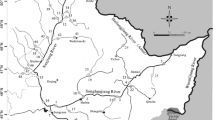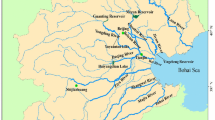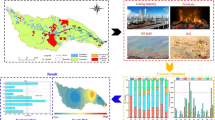Abstract
Samples were collected from the middle and lower reaches of the Yangtze River, China, to study the concentrations, distributions, and compositions of 16 US-EPA priority polycyclic aromatic hydrocarbons (PAHs) in water and suspended particulate matter (SPM). We also evaluated sources of the PAHs and their potential toxicity. Total concentrations of the PAHs (ΣPAHs) in water ranged from 17.33 to 77.12 ng L−1, and in SPM, the levels ranged from 595.91 to 2473.74 ng g−1. Total concentrations of seven carcinogenic PAHs (ΣCPAHs) ranged from 7.63 to 13.02 ng L−1 in water and 276.55 to 1216.89 ng g−1 in SPM. PAH levels in water samples were relatively low, and those in the lower reaches were higher than in the middle reaches. SPM samples had higher levels of PAHs, especially in the lower reaches and in Dongting Lake and Poyang Lake. Principal component analysis (PCA) with multiple linear regression analysis (MLR) was performed to quantitatively characterize the PAH sources. Two factors and their contributions were identified from water samples. Coal and wood combustion accounted for 74.1 % of the PAHs, and petroleum emissions explained 25.9 % of the PAHs. Three source factors were identified from SPM samples: these were vehicular emissions (46.3 % of PAHs), wood and coal combustion (40.4 % of PAHs), and petrogenic sources (13.3 %). Ecological risk assessment indicated that a moderate undesirable impact will be caused by PAHs, and some control measures and remedial actions should be conducted.






Similar content being viewed by others
References
Aziz F, Syed JH, Malik RN, Katsoyiannis A, Mahmood A, Li J, Zhang G, Jones KC (2014) Occurrence of polycyclic aromatic hydrocarbons in the Soan River, Pakistan: insights into distribution, composition, sources and ecological risk assessment. Ecotoxicology and environmental safety 109:77–84
Bertilsson S, Widenfalk A (2002) Photochemical degradation of PAHs in freshwaters and their impact on bacterial growth-influence of water chemistry. Hydrobiologia 469:23–32
Cao Z, Liu J, Luan Y, Li Y, Ma M, Xu J, Han S (2010) Distribution and ecosystem risk assessment of polycyclic aromatic hydrocarbons in the Luan River, China. Ecotoxicology 19:827–837
Dahle S, Savinov VM, Matishov GG, Evenset A, Næs K (2003) Polycyclic aromatic hydrocarbons (PAHs) in bottom sediments of the Kara Sea shelf, Gulf of Ob and Yenisei Bay. Science of the Total Environment 306(1):57–71
Deyerling D, Wang J, Hu W, Westrich B, Peng C, Bi YH, Henkelmann B, Schramm KW (2014) PAH distribution and mass fluxes in the Three Gorges Reservoir after impoundment of the Three Gorges Dam. Science of the Total Environment 491:123–130
Ding YH, Chan JCL (2005) The East Asian summer monsoon: an overview. Meteorology and Atmospheric Physics 89:117–142
Doong RA, Lin YT (2004) Characterization and distribution of polycyclic aromatic hydrocarbon contaminations in surface sediment and water from Gao-ping River, Taiwan. Water Research 38(7):1733–1744
Eisma D (1998) Intertidal deposits: river mouths. Tidal Flats and Coastal Lagoons. CRC Press, Boca Raton, p 459
Feng CL, Xia XH, Shen ZY, Zhou Z (2007) Distribution and sources of polycyclic aromatic hydrocarbons in Wuhan section of the Yangtze River, China. Environment Monitor Assessment 133:447–458
Harrison RM, Smith DJT, Luhana L (1996) Source apportionment of atmospheric polycyclic aromatic hydrocarbons collected from an urban location in Birmingham, UK. Environmental Science & Technology 30(3):825–832
Kalf D F, Corommentuijn T, van de Plassche EJ (1997) Environmental quality objectives for 10 polycyclic aromatic hydrocarbons (PAHs). Ecotoxicol Enuiron Safety 36: 89–97
Jenkins BM, Jones AD, Turn SQ, Williams RB (1996) Emission factors for polycyclic aromatic hydrocarbons from biomass burning. Environmental Science & Technology 30(8):2462–2469
Kavouras IG, Koutrakis P, Tsapakis M, LagoudakI E, Stephanou EG, Von Baer D, Oyola P (2001) Source apportionment of urban particulate aliphatic and polynuclear aromatic hydrocarbons (PAHs) using multivariate methods. Environmental science & technology 35(11):2288–2294
Lee B, Dong TT (2010) Effects of road characteristics on distribution and toxicity of polycyclic aromatic hydrocarbons in urban road dust of Ulsan, Korea. Journal of hazardous materials 175:540–550
Li BH, Feng CH, Li X, Chen YX, Niu JF, Shen ZY (2012) Spatial distribution and source apportionment of PAHs in surficial sediments of the Yangtze Estuary, China. Marine Pollution Bulletin 64:636–643
Li G, Xia X, Yang Z, Wang R, Voulvoulis N (2006) Distribution and sources of polycyclic aromatic hydrocarbons in the middle and lower reaches of the Yellow River, China. Environmental Pollution 144(3):985–993
Li P, Cao J, Diao X, Wang B, Zhou H, Han Q, Li Y (2015) Spatial distribution, sources and ecological risk assessment of polycyclic aromatic hydrocarbons in surface seawater from Yangpu Bay, China. Marine pollution bulletin 93(1):53–60
Lima AL, Farrington JW, Reddy CM (2005) Combustion-derived polycyclic aromatic hydrocarbons in the environment-a review. Environmental Forensics 6:109–31
Lipiatou E, Tolosa I, Simo R, Bouloubassi I, Dachs J, Marti S, Sicre MA, Bayona JM, Grimalt JO, Saliott A, Albaiges J (1997) Mass budget and dynamics of polycyclic aromatic hydrocarbons in the Mediterranean Sea. Deep Sea Research II 44:881–905
Liu GR, Peng X, Wang RK, Tian YZ, Shi GL, Wu JH, Feng YC (2015) A new receptor model-incremental lifetime cancer risk method to quantify the carcinogenic risks associated with sources of particle-bound polycyclic aromatic hydrocarbons from Chengdu in China. Journal of hazardous materials 283:462–468
Liu X, Jia H, Wang L, Qi H, Ma W, Hong W, Guo J, Yang M, Sun Y, Li YF (2013) Characterization of polycyclic aromatic hydrocarbons in concurrently monitored surface seawater and sediment along Dalian coast after oil spill. Ecotoxicology and Environmental Safety 90:151–156
Marrucci A, Marras B, Campisi SS, Schintu M (2013) Using SPMDs to monitor the seawater concentrations of PAHs and PCBs in marine protected areas (Western Mediterranean). Marine Pollution Bulletin 75:69–75
Milliman JD, Meade RH (1983) World-wide delivery of river sediment to the oceans. Journal of Geology 91(1):1–21
Milliman JD, Syvitski JPM (1992) Geomorphic/tectonic control of sediment discharge to the ocean: the importance of small mountainous rivers. Journal of Geology 100(5):525–544
Mitra S, Bianchi TS (2003) A preliminary assessment of polycyclic aromatic hydrocarbon distributions in the lower Mississippi River and Gulf of Mexico. Marine Chemistry 82:273–288
Montuori P, Triassi M (2012) Polycyclic aromatic hydrocarbons loads into the Mediterranean Sea: estimate of Sarno River inputs. Marine Pollution Bulletin 64:512–520
Motelay-Massei A, Garbon B, Tiphagne-larcher K, Chevereuil M, Ollivon D (2006) Mass balance for polycyclic aromatic hydrocarbons in the urban watershed of Le Havre (France): Transport and fate of PAHs from the atmosphere to the outlet. Water Research 40:1995–2006
NBSC (National Bureau of Statistics of China), 2014. China Economic Yearbook in 2014 (Beijing).
Parinos C, Gogou A, Bouloubassi I, Stavrakakis S, Plakidi E, Hatzianestis I (2013) Sources and downward fluxes of polycyclic aromatic hydrocarbons in the open southwestern Black Sea. Organic Geochemistry 57:65–75
Peters CA, Knightes CD, Brown DG (1999) Long-term composition dynamics of PAH containing NAPLs and implications for risk assessment. Environmental Science Technology 33:4499–4507
Qiu YW, Zhang G, Liu GQ, Guo LL, Li XD, Wai O (2009) Polycyclic aromatic hydrocarbons (PAHs) in the water column and sediment core of Deep Bay, South China. Estuarine Coastal and Shelf Science 83:60–66
Qiao M, Wang C, Huang, S, Wang D, Wang Z (2006) Composition, sources, and potential toxicological significance of PAHs in the surface sediments of the Meiliang Bay, Taihu Lake, China. Environ Int; 32:28–33
Rogge WF, Hlldemann LM, Mazurek MA, Cass GR (1993) Sources of fine organic aerosol. 2. Noncatalyst and catalyst-equipped automobiles and heavyduty diesel trucks. Environmental Science Technology 27:636–651
Saha M, Togo A, Mizukawa K, Murakami M, Takada H, Zakaria MP, Chiem NH, Tuyen BC, Prudente M, Boonyatumanond R, Sarkar SK, Bhattacharya B, Mishra P, Tana TS (2009) Sources of sedimentary PAHs in tropical Asian waters: differentiation between pyrogenic and petrogenic sources by alkyl homolog abundance. Marine Pollution Bulletin 58:189–200
Shaw M, Tibbetts IR, Müller JF (2004) Monitoring PAHs in the Brisbane River and Moreton Bay, Australia, using semipermeable membrane devices and EROD activity in yellowfin bream, Acanthopagrus australis. Chemosphere 56:237–246
Shi GL, Li X, Feng YC, Wang YQ, Wu JH, Li J, Zhu T (2009) Combined source apportionment, using positive matrix Factorization-chemical mass balance and principal component analysis/multiple linear regression chemical mass balance models. Atmospheric Environment 43(18):2929–2937
Simoneit BRT (2002) Biomass burning—a review of organic tracers for smoke from incomplete combustion. Applied. Geochemistry 17:129–162
Simcik MF, Eisenreich SJ, Lioy PJ (1999) Source apportionment and source/sink relationships of PAHs in the coastal atmosphere of Chicago and Lake Michigan. Atmospheric Environment 33(30):5071–5079
Sinaei M, Mashinchian A (2014) Polycyclic aromatic hydrocarbons in the coastal sea water, the surface sediment and Mudskipper Boleophthalmus dussumieri from coastal areas of the Persian Gulf: source investigation, composition pattern and spatial distribution. Journal of Environmental Health Science & Engineering 12(1):59–70
Sofowote UM, Mccarry BE, Marvin CH (2008) Source apportionment of PAH in Hamilton Harbour suspended sediments: comparison of two factor analysis methods. Environmental Science and Technology 42(16):6007–6014
Sun JL, Ni HG, Zeng H (2012) Ecological risk assessment of parent and halogenated polycyclic aromatic hydrocarbons in surface sediments from an urban river in south China. Environmental Toxicology Chemistry 31:1867–1873
Thurston GD, Spengler JD (1985) A quantitative assessment of source contributions to inhalable particulate matter pollution in metropolitan Boston. Atmospheric Environment 19(1):9–25
Tian YZ, Li WH, Shi GL, Feng YC, Wang YQ (2013) Relationship between PAHs and PCBs, and quantitative source apportionment of PAHs toxicity in sediments from Fenhe reservoir and watershed. Journal of Hazardous Material 248–249:89–96
Tu J (2014) Water quality evaluation research of water function areas in the Yangtze River downstream based on GIS, PhD Dissertation, Nanjing University., pp 1–3
Wang C, Wu S, Zhou S, Wang H, Li B, Chen H et al (2015a) Polycyclic aromatic hydrocarbons in soils from urban to rural areas in nanjing: concentration, source, spatial distribution, and potential human health risk. Science of the Total Environment, s 527–528:375–383
Wang JZ, Guan YF, Ni HG, Luo XL, Zeng EY (2007) Polycyclic aromatic hydrocarbons in riverine runoff of the Pearl River Delta (China): concentrations, fluxes, and fate. Environmental Science and Technology 41:5614–5619
Wang L, Yang Z, Niu J, Wang J (2009) Characterization, ecological risk assessment and source diagnostics of polycyclic aromatic hydrocarbons in water column of the Yellow River Delta, one of the most plenty biodiversity zones in the world. Journal of hazardous materials 169(1):460–465
Wang P, Shang H, Li H, Wang Y, Li Y, Zhang H, Jiang G (2016) PBDEs, PCBs and PCDD/Fs in the sediments from seven major river basins in China: Occurrence, congener profile and spatial tendency. Chemosphere 144:13–20
Wang Y, Li X, Li BH, Shen ZY, Feng CH, Chen YX (2012) Characterization, sources, and potential risk assessment of PAHs in surface sediments from nearshore and farther shore zones of the Yangtze estuary, China. Environmental Science and Pollution Research 19(9):4148–4158
Wang YB, Liu CW, Kao YH, Jang CS (2015b) Characterization and risk assessment of PAH-contaminated river sediment by using advanced multivariate methods. Science of The Total Environment 524:63–73
Yan B, Abrajano TA, Bopp RF, Chaky DA, Benedict LA, Chillrud SN (2005) Molecular tracers of saturated and polycyclic aromatic hydrocarbon inputs into Central Park Lake, New York City. Environmental Science and Technology 39:7012–7019
Yan B, Abrajano TA, Bopp RF, Benedict LA, Chaky DA, Perry E, Song J, Keane DP (2006) Combined application of d13C and molecular ratios in sediment cores for PAH source apportionment in the New York/New Jersey harbor complex. Organic Geochemistry 37:674–687
Yunker MB, Snowdon LR, Macdonald RW, Smith JN, Fowler MG, Skibo DN, McLaughlin FA, Danyushevskaya AI, Petrova VI, Ivanov GI (1996) Polycyclic aromatic hydrocarbon composition and potential sources for sediment samples from the Beaufort and Barents Seas. Environmental Science and Technology 30:1310–1320
Yunker MB, Macdonald RW, Vingarzan R, Mitchell RH, Goyette D, Sylvestre S (2002) PAHs in the Fraser River basin: a critical appraisal of PAH ratios as indicators of PAH source and composition. Organic. Organic Geochemistry 33:489–515
Zhang XL, Tao S, Liu WX, Yang Y, Zuo Q, Liu SZ (2005) Source diagnostics of polycyclic aromatic hydrocarbons based on species ratios: a multimedia approach. Environmental Science and Technology 39(23):9109–9114
Zhang YX, Tao S (2009) Global atmospheric emission inventory of polycyclic aromatic hydrocarbons (PAHs) for 2004. Atmosphere Environment 43:812–819
Zhang Y, Guo CS, Xu J, Tian YZ, Shi GL, Feng YC (2012) Potential source contributions and risk assessment of PAHs in sediments from Taihu Lake, China: comparison of three receptor models. water research 46(9):3065–3073
Zhao YF, Zou XQ, Gao JH, Xu XWH, Wang CL, Tang DH, Wang T, Wu XW (2015) Quantifying the anthropogenic and climatic contributions to changes in water discharge and sediment load into the sea: A case study of the Yangtze River, China. Science of the Total Environment 536:803–812
Zhi H, Zhao Z, Zhang L (2015) The fate of polycyclic aromatic hydrocarbons (PAHs) and organochlorine pesticides (OCPs) in water from Poyang Lake, the largest freshwater lake in China. Chemosphere 119:1134–1140
Acknowledgments
This study was supported by the National Basic Research Program of China (grant no. 2013CB956503) and the National Natural Science Foundation of China (grant no. 41471431).
Author information
Authors and Affiliations
Corresponding author
Additional information
Responsible editor: Ester Heath
Electronic supplementary material
Below is the link to the electronic supplementary material.
ESM 1
(DOC 62 kb)
Rights and permissions
About this article
Cite this article
Wang, C., Zou, X., Zhao, Y. et al. Distribution, sources, and ecological risk assessment of polycyclic aromatic hydrocarbons in the water and suspended sediments from the middle and lower reaches of the Yangtze River, China. Environ Sci Pollut Res 23, 17158–17170 (2016). https://doi.org/10.1007/s11356-016-6846-3
Received:
Accepted:
Published:
Issue Date:
DOI: https://doi.org/10.1007/s11356-016-6846-3




